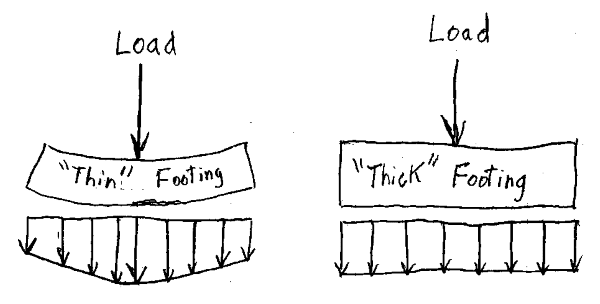JoanWill,
Let me try to answer your questions and concerns.
JoanWill said:
I don't see much consideration is given to the deflection of footing. Is it because when we design the footing we are using the allowable bearing capacity instead of ultimate one? If so, does it mean that what founding material (either clay or rock or whatever) is doesn't matter as long as the strength design works fine under allowable bearing capacity?
1) For a properly sized and designed footing (satisfies shear and bending requirements), the deflection will be very small (as expected for reinforced concrete members), and in no way affecting its performance on supporting structure above. You can verify the claim of "deflection is small" by perform a few simple calculations.
2) From geotechnical engineering view point, The allowable bearing stress is interpreted as the maximum perceived pressure to produce a certain amount of settlement. The perceived pressure is derived from the soil properties and the anticipated maximum load with a safety factor much greater than the factors used in ultimate strength design. And the "certain amount of settlement" is the generally accepted settlement for the type of structure, say 1" of settlement, or 0.5" differential settlement. Thus, the actual settlement will be less than 1", or 0.5", respectively, and that's why settlement is not a concern, since the maximum perceived pressure is kept within the so called "allowable bearing stress".
3) Type of founding material is important, as different type of soil/rock posses different properties, which affect the derivation of allowable bearing pressure as explained in paragraph above.
JoanWill said:
Does the contractor simply stop when these target loading is reached? If so, what consideration of deflection is given here?
The contractor can't call "stop", the call is to be made by the project geotechnical engineer, who in turn, is responsible for soil exploration, and determine the target resistance. The target resistance is reached when pile shows no movement, or very little advancement within certain below count, which is calculated depending on the type of pile driving equipment in use, and the soil properties. The target resistance is much larger than the maximum design load anticipated, the safety factor is huge, as mentioned by SRE. For the point bearing pile, the potential for further settlement is close to nil, as the soil near the pile tip has already been densified by the pile driving force.
However, pile shortening can occur, but it's a time and sustained load dependent phenomenon, rarely critical in plie applications. For lateral displacement of pile head, it is limited to a limited amount during pile design stage through the evaluation of pile-soil-pile cap interaction. Lastly, the lateral deflection of pile within span, it is avoided through carefully selection of pile size (steel), and adequate reinforcing (concrete), the deflection should be very small.
Finally,
JoanWill said:
why does the standard say "earthquake serviceability actions need not be taken into account" considering the piles will be driven to reach (above) the target loading caused by earthquake and no significant movement anyway? In another way, how can they consider the settling for gravity loads only when loading caused by earthquake is greater than the DL+LL?
I still couldn't make sense out of your question(s). It is quite difficult to understand the intent of a "standard" without reading the whole article. Does the standard has commentary? Which may help you to understand its intent, and applicability. Also, inputs from geotechnical engineer should be immensely helpful.


![[idea] [idea] [idea]](/data/assets/smilies/idea.gif)
